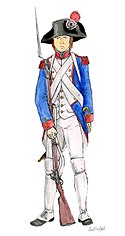Army of the Rhine and Moselle
| Army of the Rhine and Moselle | |
|---|---|

Fusilier of a French Revolutionary Army
|
|
| Active | 20 April 1795 – 29 September 1797 |
| Country | |
| Allegiance | First Republic |
| Disbanded | 29 September 1797 and units merged into Army of Germany |
| Commanders | |
| Notable commanders |
Jean-Charles Pichegru Jean Victor Marie Moreau Louis Desaix Laurent de Gouvion Saint-Cyr |
The Army of the Rhine and Moselle (French: Armée de Rhin-et-Moselle) was one of the field units of the French Revolutionary Army. It was formed on 20 April 1795 by the merger of elements of the Army of the Rhine and the Army of the Moselle. On 29 September 1797, the Army of the Rhine and Moselle merged with the Army of the Sambre and Meuse to form the Army of Germany.
The Army figured in two principal campaigns in the War of the First Coalition. By this time, military planners in Paris formed armies based on specific strategic tasks, and the task of this Army was to, first, secure the French frontier at the Rhine river, and second, to penetrate into the German states, potentially threatening Vienna. The unsuccessful 1795 campaign concluded with the removal of General Jean-Charles Pichegru from command. In 1796, the army, under command of General Jean Victor Marie Moreau, proved itself more successful. After crushing the Reichsarmee's elements at Kehl, the Army advanced well into southwestern Germany. In late summer, the Habsburg commander, Archduke Charles, Duke of Teschen, push the French back to France.
The Army of the Rhine and Moselle experienced excruciating command problems in its early operations, and these were especially problematic in campaign failures of 1795. In 1796, the jealousies between commanders complicated the efficient operations of the Army. After a summer of maneuver in which the Coalition force drew the French deeper and deeper into German territory, Archduke Charles, Duke of Teschen, the Habsburg commander, drubbed the French at Wurzburg and second Wetzlar and then defeated Jean-Baptiste Jourdan's army at the Limburg-Altenkirchen, destroying any chance that Jourdan's force and Moreau's Army of the Rhine and Moselle could merge. Once Jourdan was eliminated from support and withdrew to the west bank of the Rhine, Charles could focus his attention on Moreau. By October, they were fighting on the western slope of the Black Forest and by December, Charles had the French forces under siege at the principal river crossings of Kehl and Hüningen. By early 1797, the French had relinquished control of the bridgeheads over the Rhine.
...
Wikipedia
